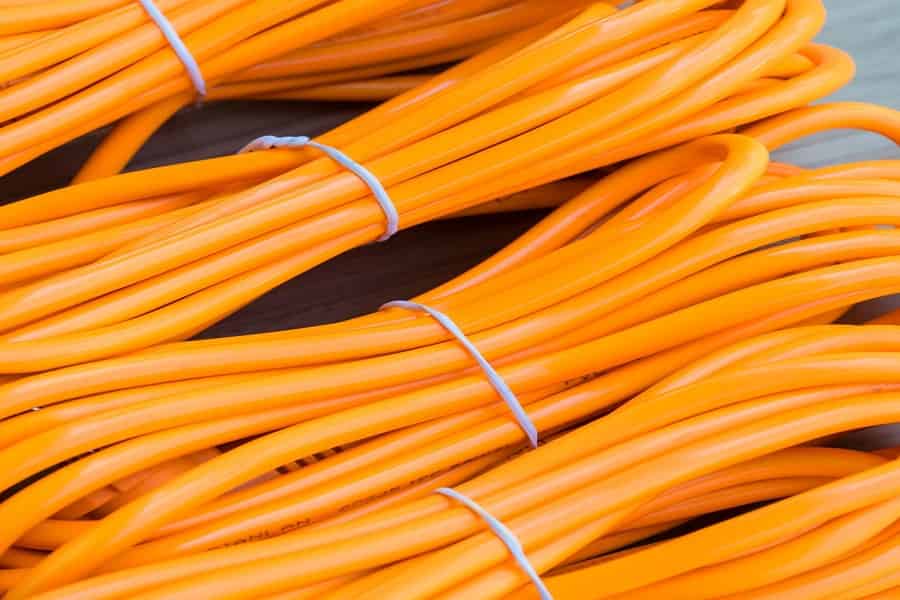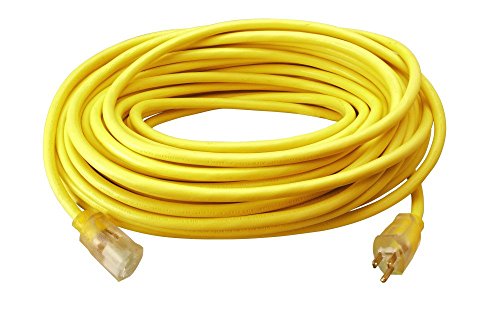Since the Industrial Revolution, extension cords have supplied temporary power in various indoor and outdoor environments. But trying to find an extension cord made here in the U.S. can be time-consuming these days. (Below) after researching, I’ve put together a helpful list with pictures of extension cords made in USA, including light to heavy-duty, and are conveniently available online. In addition, I also provide brief, helpful information about extension cords to help you make the best choice.
Related Resources: Space heater made in USA, Best drill press under $200
How to Store an Extension Cord (With an Ideal Practical Gadget)
From time to time, you come across one of those homeowner items that you can’t imagine being without. Well, the Wonder Winder is one of those items. Here’s how this nifty gadget can easily manage your extension cord.
I’ve used various cord retrieval and storage devices, and there are plenty of low-cost units. I’ve used the stand-up cord reels and the reels that have that center twist grip. The disadvantage I experienced with these units is that it takes two or more hands to unwind and retrieve the cord. And making any homeowner task much more time-consuming and challenging.
With the Wonder Winder, you don’t have this inconvenience. The Wonder Winder is very durable, has a simple design, and performs very well. Here’s how it works.
Once you install the unit, you thread your extension cord through the top and off the unit and down between the pressure paddle and the rubber-coated swivel wheel. After the cord is threaded through the friction wheel, you pull the cord through the device and down through the basket. And then stretch the cord far enough to reach the socket. And then, you’ll want to secure the cord to the bottom of the basket with the cord anchor.
The Wonder Winder is portable and designed to be used indoors and outdoors. It comes with a reversible handle to use whether you are right or left-handed. Can hold up to 75 ft. of 12/3 cord, 100 ft. of 14/3 cord, or up to 150 ft. of 16/3 cord.
I’m currently using 100 feet of 14/3 cord and can coil the entire length of that cord in around thirty seconds. The great thing is that I can have my hands full of tools, grab the end of the cord, and start my next home project. You don’t have to worry about stuff getting tangled or snagged. After the project is finished, coil up the cord to store it neatly.
Retrieving the cord is easy; apply light pressure by turning the crank. This action allows you to quickly and easily retrieve the cord and store it in the basket hanging below the unit. You must also make sure it is near an electrical outlet for installation.
Related Resource: Bench grinder made in USA
How to Use an Extension Cord (With 7 Helpful Tips)
Although using an extension cord should be a reasonably straightforward task, there are other things to remember when using extension cords. The following are seven helpful tips to keep in mind to ensure the proper use of extension cords at home.
- Do not fill the outlets: If there are enough outlets on an extension cord, that doesn’t mean you can fill them up.
- Do not exceed the current: Make sure you do not exceed the required current.
- Ensure cords don’t dangle: They can trip and be pulled out of the wall.
- Don’t plug one extension cord into another: Avoid plugging extension cords into each other because you could overload the wiring circuits and overheat.
- Do not plug a three-pin cord into a two-pin extension cord: This may overload the cord.
- Store the extension cord: When you are finished using an extension cord, put it away to avoid tripping and keep it in good condition.
- Do not store extension cords outdoors: This prevents the jacket from cracking.
Related Resource: Jumper cables made in USA
4 Essential Factors in Choosing an Extension Cord
When looking for an extension cord, some aspects include environment, cord designations, power, and gauge rating.
Environment and Cord Designations
The first thing to account for is the environment and cord designations. For example, suppose you will use your extension cord in cold, wet, or outdoor environments. In that case, you will need a different type of extension cord than if you need to plug in a household lamp in the living room.
Most information about the durability and intended use of a cord is obtained by looking at the type of jacket. The jacket is the cord’s outer sheath and is assigned a letter for code designation, such as SJ, S, T, E, W, O, OO.
- Designation SJ: An SJ on the cord means it is rated for 300 volts.
- Designation S: An S without J on the cable means it is rated for 600 volts.
- Designation T: The letter T on the cable represents that it has a thermoplastic sheath, which means that it is intended for light-duty use.
- Designation E: The letter E on the cable represents that it has an elastomeric sheath and is intended for medium-duty use.
- Note: There is no letter designated for heavy-duty; therefore, if there is no T or E on the cable, it is heavy-duty.
- Designation W: The letter W on the cable means it is rated for wet conditions and direct sunlight.
- Designation O: An O on the cord means it has an oil-resistant jacket.
- Designation OO: And finally, a double O on the cord means that it has an oil-resistant jacket and insulation.
Related Resource: Floor fan made in USA
Power Rating
Each extension cord has a maximum amperage that it can safely carry. Suppose your device or tool draws more amperage than the cord can handle. In that case, the device or tool may not operate properly, and the cord may overheat.
The power usage of devices varies widely. For example, a light may use only half an amp, while a leaf blower may draw 12 amps. To find the right extension cord, be sure to check the amperage of the device or tool motor you are using. And that the cord you are using offers the same amperage or more.
Related Resource: Bottle jack made in USA
Gauge Rating
The wire gauge measures the diameter of the conductor wires within the cord. The smaller the number, the larger the gauge, which means higher current capacity. For example, extension cords range from 18 gauge to 10 gauge, with ten gauge being the thickest.
Most larger gauge extension cords are thin and compact, like 18 gauge, and typically made for use with electronics that don’t need a lot of power. They are also known as lightweight cords for applications, including:
- Lamps
- Alarm clocks
- Fans and more
A 14 gauge extension cord is for medium-duty applications such as:
- Lawnmowers
- Power drills
- Table saws
A 10 to 12 gauge extension cord is for heavy and highly heavy-duty applications such as:
- Chainsaws
- Circular saws
- Shop vacs
- Air compressors
Let’s assume a scenario where you are doing industrial work in the field and need an extension cord to be used with:
- A 120-volt outlet
- 100 feet away
- Direct sunlight
- Near water
- To power a pipe threader
Note that a standard pipe threader has an amperage of 13 amps and discharges significant amounts of oil.
What gauge and code sequence should you look for in your extension cord? Answer: In this environment with this particular scenario, the extension cord you will need is a 14 gauge AWG/SJOOW.
- SJ: The SJ signifies that it is rated for use up to 300 volts.
- OO: The double O represents that it is rated for use around oil.
- W: The W signifies that it is for outdoor use, such as in wet conditions or direct sunlight.
And that is all; I hope this gives you a better understanding of how to correctly select the right extension cord for use with equipment for different tasks and environments. All of these ratings are usually stamped on the cable jacket. So if you lose the packaging or drop a label, you can make sure you’re using the right extension cord for the job.
Related Resource: Water heater made in USA
Detect Improper Use of Extension Cords in the Workplace (In 2 Easy Steps)
(Below) Let’s identify the improper use of extension cords in the workplace by following these two simple steps.
1. Look for the Colors of the Extension Cords
When you do your audits, start looking for the colors of extension cords on the job site, such as orange, fluorescent green, yellow, and sometimes black. Those are usually the colors of the extension cords and will help you detect them easily.
You want to identify any extension cord used instead of permanent wiring to a structure, as it is prohibited. You can only use extension cords for 90 days or less in a work area. Ninety days would be for holiday decorations or possibly a piece of equipment frequently being moved from one location to another, and you need to power it.
2. Look for Any Extension Cords Tied to a Structure
So when you are doing your audit, look for an extension cord wrapped around a structure or tied to a piece of the structure. Suppose you find any extension cord tied to a structure. In that case, this indicates that it is not used temporarily and might be used in place of permanent wiring to a structure.
One of the problems with tying an extension cord to a structure is that the insulation on extension cords is not always that great and can wear out over time. As I mentioned earlier, you can use extension cords temporarily but not in place of permanent wiring.
Related Resources: Drill bits made in USA, Brand of tools made in USA list, How to choose the right 300ft extension cord









